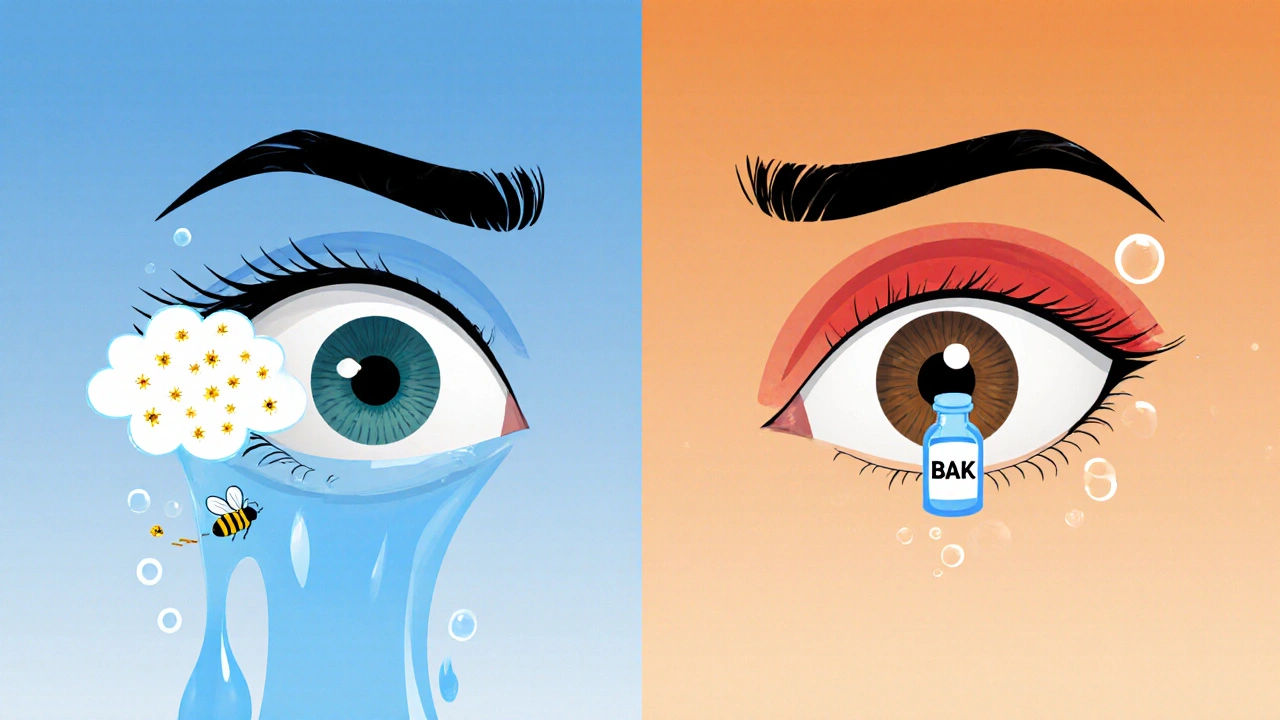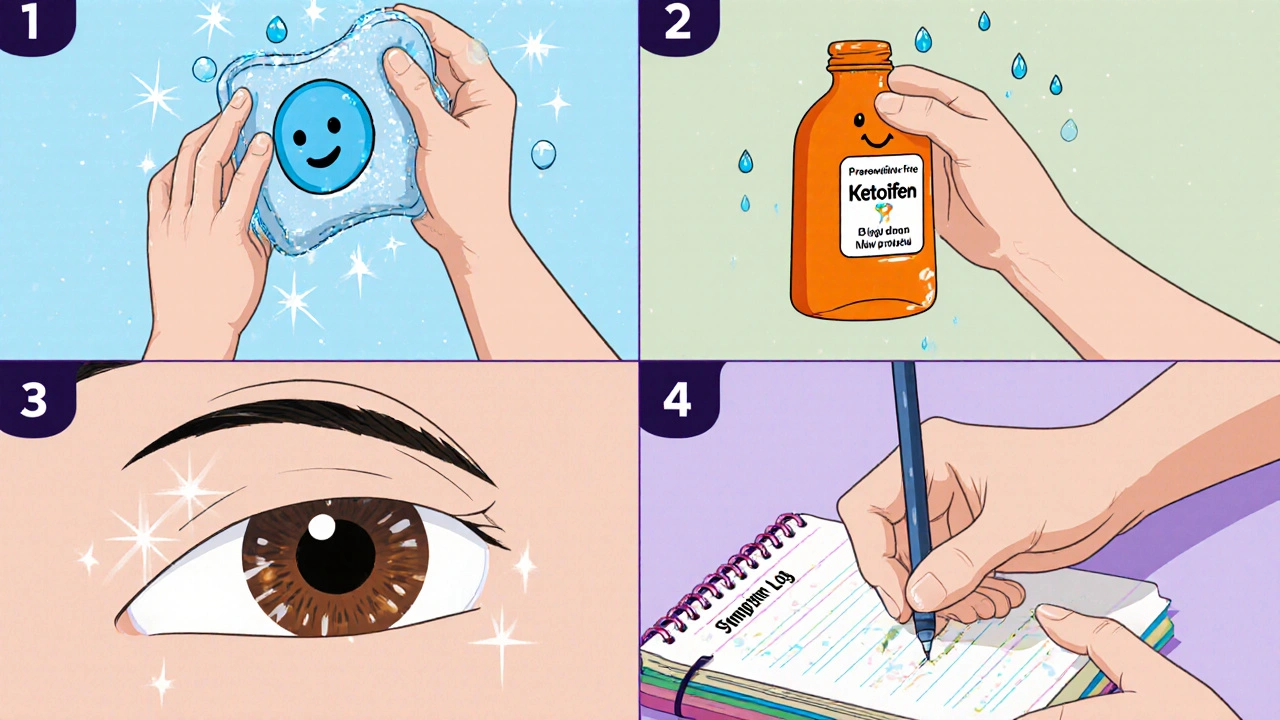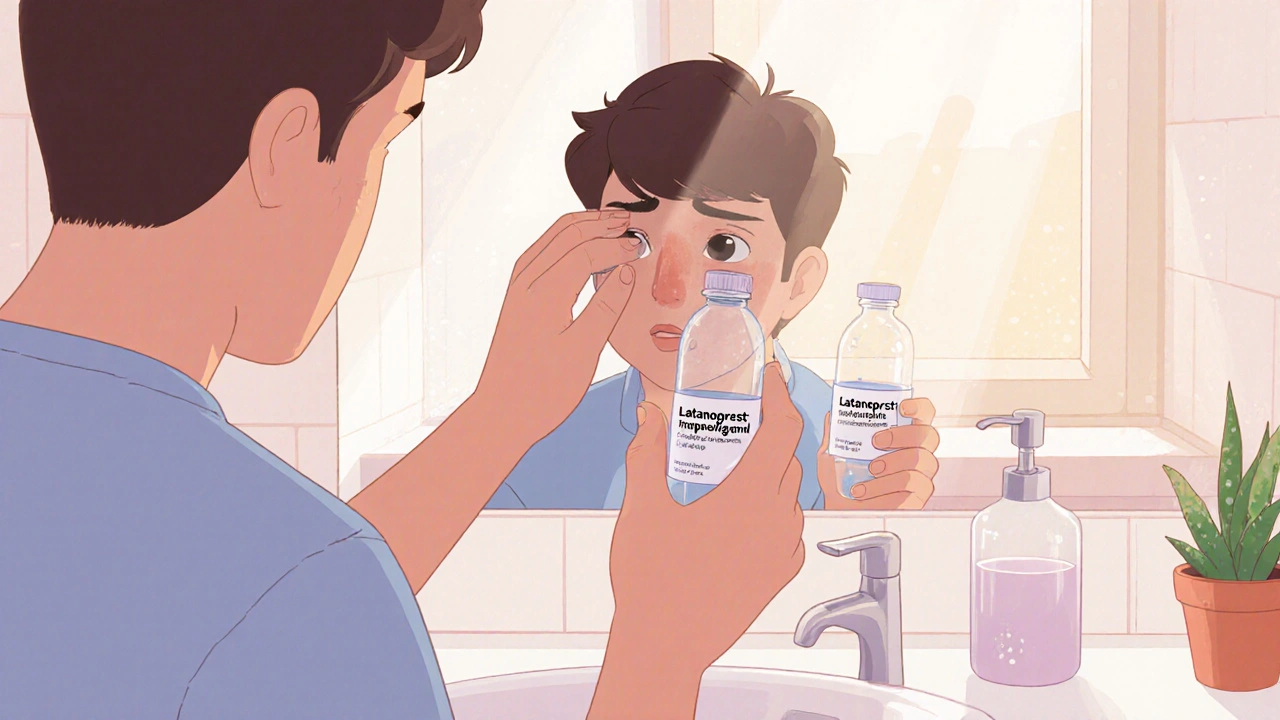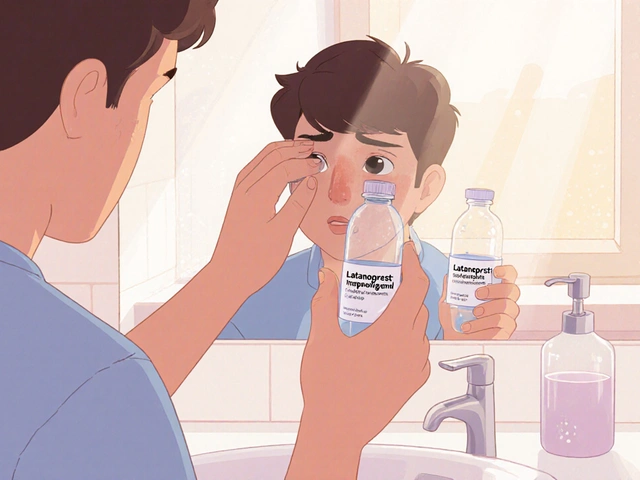Latanoprost Symptom Checker
Answer the following questions about your symptoms to determine if your eye irritation is likely due to an allergy or the preservative in your latanoprost.
When patients with glaucoma use Latanoprost is a prostaglandin F‑type analog prescribed to lower intra‑ocular pressure. It works by increasing fluid outflow through the eye’s drainage pathways. However, many report itching, redness, or a gritty feeling that feels a lot like an allergy. If you’re wondering whether you’re dealing with a drug reaction or a true eye allergy, you’re not alone. Below you’ll find a practical roadmap to identify the cause, calm the irritation, and keep your vision safe.
Why Latanoprost Can Trigger Eye‑Allergy‑Like Symptoms
Latanoprost itself isn’t an allergen, but its formulation often contains preservatives such as benzalkonium chloride (BAK). BAK helps keep the bottle sterile, yet it can irritate the ocular surface, especially in people with sensitive eyes. The irritation activates mast cells, leading to histamine release - the same chemical cascade that drives classic allergic conjunctivitis.
In addition, prostaglandin analogs can cause changes in the eyelash follicles and pigmented spots on the iris. Those changes are harmless but can make the eye look inflamed, adding to the confusion.
Spotting the Difference: Allergy vs. Drug Side‑Effect
- Timing: A true allergy may flare up after exposure to pollen, pet dander, or dust and often improves in low‑allergen environments. Drug‑related irritation usually starts within days of starting or switching eye drops.
- Symptoms: Allergies typically present with watery discharge, stringy mucus, and intense itching. Preservative irritation tends to cause burning, a gritty sensation, and sometimes mild redness without mucus.
- Response to Antihistamines: If antihistamine eye drops bring rapid relief, you’re probably dealing with an allergic reaction. Little to no effect suggests a preservative issue.
Understanding these clues helps you decide whether to tweak your drop routine or reach for an allergy‑specific remedy.
Step‑by‑Step Guide to Manage Symptoms
- Stop using the suspected drop for 24‑48hours. Switch temporarily to preservative‑free artificial tears to keep the surface lubricated.
- Apply a cold compress for 5minutes, three times a day. The cooling effect reduces mast‑cell degranulation and eases itching.
- If itching persists, use an over‑the‑counter antihistamine eye drop such as ketotifen. Follow the package instructions - usually one drop per eye twice daily.
- Consider oral antihistamines (e.g., cetirizine 10mg) if your eyes are part of a broader seasonal allergy picture.
- Re‑introduce latanoprost after symptoms improve, but opt for a preservative‑free version if available. Many pharmacies now stock BAK‑free formulations.
- Keep a symptom diary. Note the date, drop brand, any other eye products used, and environmental factors (pollen count, humidity). This record becomes valuable if you need to see an eye‑care professional.
Most people find relief within a week. If redness or discomfort lasts longer, it’s time to get professional input.

Safe Eye‑Care Products to Use
| Product | Key Ingredient | Preservative? | Typical Use | Pros | Cons |
|---|---|---|---|---|---|
| Preservative‑free artificial tears | Hydroxypropyl methylcellulose | No | Lubricate 2‑4×/day | Gentle, safe with any drop | May need frequent dosing |
| Ketotifen antihistamine drops | Ketotifen fumarate | Yes (often BAK) | 2×/day | Fast itch relief | Potential mild irritation |
| Olopatadine prescription drops | Olopatadine hydrochloride | No (preservative‑free versions exist) | Once daily | Long‑acting, low irritation | Requires prescription |
| Oral cetirizine | Cetirizine | Not applicable | Once daily | Systemic allergy control | May cause drowsiness in some |
Pick a combination that matches your lifestyle. For most latanoprost users, preservative‑free tears plus an occasional antihistamine drop strike the right balance.
When to Call Your Eye Doctor
- Redness or pain that worsens after 48hours of self‑care.
- Sudden loss of vision, flashes, or new floaters.
- Signs of infection: thick yellow discharge, swelling, or fever.
- Persistent itching despite antihistamine treatment.
These symptoms could signal a secondary infection, uveitis, or an adverse reaction that needs prescription‑strength medication or a change in your glaucoma regimen.

Preventive Tips for Future Flare‑Ups
- Store eye drops in a cool, dry place and discard after the manufacturer’s expiration date (usually 30days after opening).
- Use a clean, lint‑free cloth to wipe the tip before each application - this reduces bacterial load.
- Avoid rubbing your eyes after instilling drops; the motion can spread preservatives across the ocular surface.
- Consider a yearly allergy test if seasonal symptoms are severe. Tailored immunotherapy can lower overall eye‑allergy burden.
- Schedule regular follow‑ups with your ophthalmologist to monitor intra‑ocular pressure and eye‑surface health.
By integrating these habits, you keep both your glaucoma under control and your eyes comfortable.
Quick Recap of Key Actions
- Identify if symptoms are allergy‑related or preservative‑induced.
- Pause latanoprost briefly, use preservative‑free tears.
- Apply cold compresses and antihistamine drops as needed.
- Re‑introduce a BAK‑free latanoprost formulation when irritation subsides.
- Seek professional care for worsening pain, vision changes, or persistent itching.
Frequently Asked Questions
Can latanoprost itself cause an allergic reaction?
Latanoprost is not a known allergen, but the preservatives in many commercial bottles can irritate sensitive eyes, mimicking an allergy.
How long should I wait before restarting latanoprost after symptoms improve?
Usually 24-48hours of symptom‑free interval is enough. Start with a preservative‑free version to see if irritation recurs.
Are over‑the‑counter antihistamine eye drops safe to use with latanoprost?
Yes, they can be combined, but space applications by at least 5minutes to avoid wash‑out. If you notice increased redness, stop and consult your doctor.
What is the best preservative‑free artificial tear for glaucoma patients?
Brands like Refresh Optive Advanced and Systane Ultra (preservative‑free packs) are commonly recommended because they contain hyaluronic acid, which supports the ocular surface.
Should I switch to a different glaucoma medication if I keep having allergies?
Only after a thorough eye‑exam. Alternatives like bimatoprost or travoprost also belong to the prostaglandin class and may have similar preservative issues, so a preservative‑free formulation is usually the first tweak.








Kevin Adams October 16, 2025
Ever feel like your eyes are staging a tiny rebellion against the drops? The way Latanoprost nudges fluid out is brilliant, yet the BAK preservatives can feel like tiny protestors. I like to picture a microscopic protest march-tiny flags of irritation waving. In the end, a brief hiatus and some preservative‑free tears calm the crowd.
Patricia Echegaray October 17, 2025
Wake up, America! They don’t want you to know that big pharma sneaks chemicals into eye drops to keep us dependent. Those preservatives are a silent weapon, making us think it’s an allergy while they tighten the grip on our vision. Grab preservative‑free options and stay vigilant – the truth is out there.
CHIRAG AGARWAL October 17, 2025
Look, the guide is fine but most people just skim. If you stop the drop for a day and use plain tears you’ll see the difference. No need to overthink it.
genevieve gaudet October 17, 2025
i think teh article does a good job at clearing up the confusion. its defnitely helpful for folks who r new to latanoprost. the tip about keeping a symptom diary is gold. just remember to stay consistent with the notes!
Katie Henry October 18, 2025
Dear readers, your ocular health deserves the utmost care. I encourage you to adopt the step‑by‑step protocol with diligence, especially the temporary switch to preservative‑free artificial tears. Consistency, patience, and vigilance will undoubtedly safeguard your vision while managing irritation.
Joanna Mensch October 18, 2025
The real danger is never being warned about hidden chemicals. I keep an eye out for any unexpected redness and trust my gut-if it feels off, it probably is. Stay aware, stay safe.
Nickolas Mark Ewald October 18, 2025
That’s solid advice.
Chris Beck October 18, 2025
Use plain tears. Stop the drop for 48h. Then try a cold compress. It works for many.
Tom Green October 19, 2025
Hey folks, just wanted to add that sharing your symptom diary with your ophthalmologist can really speed up finding the right solution. Collaborative care makes a big difference, so keep those notes handy and be open about any changes you notice.
Emily Rankin October 19, 2025
There is a quiet drama unfolding each time we dab a drop into our eye, a drama that many of us overlook amidst the clinical jargon. The prostaglandin analog, Latanoprost, is a hero in the fight against glaucoma, yet its sidekicks-preservatives-can feel like mischievous sprites. When the BAK molecules dance on the ocular surface, they awaken mast cells, and the itch becomes a chorus of whispers demanding attention.
First, acknowledge the timing: a flare within days of starting the medication is not a coincidence but a signal.
Second, distinguish the symptoms: watery discharge and stringy mucus shout “allergy,” while burning and gritty sensations whisper “preservative irritation.”
Third, test the response: antihistamine drops that melt the itch fast point to an allergic origin, whereas a lack of effect hints at a preservative culprit.
Now, take action. Pause the offending drop for a full 24‑48 hours; let the eye breathe. Introduce preservative‑free artificial tears to keep the surface hydrated-think of them as a gentle lullaby for inflamed tissue.
Apply a cold compress three times a day; the chill calms the overactive mast cells, reducing histamine release. If the itch persists, ketotifen eye drops become your ally, offering rapid relief without compromising ocular pressure control.
When systemic allergies flare, a low‑dose oral antihistamine such as cetirizine can provide broader comfort, but always respect dosing guidelines.
After the storm subsides, re‑introduce Latanoprost cautiously, preferably a BAK‑free formulation; the eye will reveal whether the irritant truly lies in the preservative or elsewhere.
Maintain a diligent diary: note the date, brand, any concurrent products, and even pollen counts. This ledger becomes a powerful testimony for your eye‑care professional.
Remember, most people find relief within a week, but if redness or discomfort lingers beyond 48 hours, seek professional evaluation promptly.
In sum, the journey from irritation to clarity is navigable with patience, observation, and the right tools. Your vision is too precious to be compromised by avoidable discomfort.
Rebecca Mitchell October 19, 2025
Preservative free tears work well they are gentle and simple to use
Roberta Makaravage October 20, 2025
Honestly, anyone who skips the preservative‑free option is ignoring basic ocular science 🙄. The data are clear: BAK is a known irritant, and the consensus among ophthalmologists is to switch whenever possible. If you’re still using the original bottle, you’re essentially choosing discomfort over health. 🙌
RJ Samuel October 20, 2025
Sure, the guide is good but let’s not forget that every regimen is a personal experiment. Some folks swear by the cold compress, others find it useless. The real truth is that we each have to listen to our own eyes and adjust accordingly.
Sara Werb October 20, 2025
Let me be crystal clear!!! The moment you think BAK is just a harmless additive, you’re selling yourself short!!! The irritation is real, and it’s high time you demand preservative‑free alternatives!!! Don’t let big‑pharma dictate your comfort!!!
Winston Bar October 20, 2025
Listen, the whole “just a drop” nonsense is a distraction. You keep bleeding money while they line their pockets with your tears. Take the drops, feel the burn, then throw them away and demand something better. It’s not just a habit, it’s a surrender.
Russell Abelido October 21, 2025
Hey, I see where you’re coming from and I totally feel your frustration 😊. It can be overwhelming to juggle glaucoma meds and irritation, but taking a step‑by‑step approach really helps. Remember, you’re not alone in this journey.
Steve Holmes October 21, 2025
Great points! I especially appreciate the reminder to space out antihistamine and latanoprost drops by at least five minutes; that timing detail often gets overlooked. Also, the suggestion to use a preservative‑free formulation first before considering a switch is spot‑on. Thanks for the thorough rundown!
Lauren Sproule October 21, 2025
Totally agree with the inclusive approach here. Keeping a diary and sharing it with your doc is a simple yet powerful step. It shows how teamwork can improve outcomes for everyone.